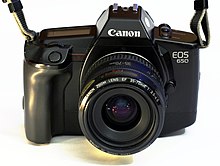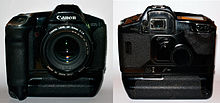Canon EOS analog cameras
The EOS series ( Electro-Optical System ) from Canon is a family of SLR cameras and matching interchangeable lenses.
If there is the extension D before or after the type designation , it is a digital model . Without this extension, these are cameras for 35mm film .
Categories
Using the model names, the models can be largely clearly categorized according to quality and features. While the professional models usually have one-digit model names (e.g. EOS 1, EOS 3), the semi-professional models usually have two digits (e.g. EOS 33, EOS 10) and the amateur models have three or four digits (e.g. EOS 300 , EOS 3000).
The designation is also expanded to include letters that document certain features or the progress of a model series. This extension is more diverse than the model name. The letters n or v were used as an extension for revised models (e.g. EOS 1N, EOS 1V), the letters RS or RT (RT for real time) identify special models with a fixed mirror, of which the designation "EOS" was derived. (e.g. EOS 1RS, EOS RT).
The models of the entry-level series were (and are) sold on the American market as EOS Rebel (DSLR: EOS Digital Rebel) and on the Japanese market as EOS Kiss (DSLR: EOS Kiss Digital ). The “two-digit” prosumer models were called EOS Elan on the American market and the EOS 7 in Japan . With the transition to the digital models of the EOS-D series, the latter names were internationally harmonized, while the differentiation in Rebel and Kiss also persists with the digital models.
Lenses
The lenses for the EOS cameras are called EF lenses . The abbreviation "EF" stands for "Electronic Focus", ie "electronic focusing". The communication between the camera and lens is purely electronic, and the control of the aperture also works through an electric drive in the lens. Older models , known as FD lenses , cannot easily be used with the newly designed bayonet connection of the EOS cameras. For this purpose Canon offered two adapters shortly after the introduction of the EF bayonet, which were only sold through Canon's professional service. These adapters were only produced in limited numbers and are therefore extremely seldom found on the used market today.
The quality and quantity of the different lenses (currently 54 EF lenses from 8 to 800 mm; the 1200 mm telephoto is no longer listed) led to widespread use in the press and professional sectors. The EF lenses can be used on both analog Canon EOS cameras and digital models.
L- class lenses are primarily designed for professional users, as they have particularly elaborately coated lens elements and are often sealed against environmental influences (such as sand and splash water). These lenses are easily recognizable by their eye-catching red ring and the red letter “L”. All older telephoto lenses of the L class also have a light gray paint finish ( RAL 7044 / silk gray ). The lenses are now painted in a different gray. Officially, the "L" stands for "Luxury". Canon also states that the “L” simply refers to “Lens”. It is repeatedly suggested that the original meaning was "asphericaL" or "Low Dispersion", but there is no evidence for this. In addition, only about half of the L lenses actually have aspherical lenses. Due to the various sources that want to define this "L", it cannot be ruled out that the designation has been consciously adapted over time - and the changing requirements of buyers - in advertising and specialist literature.
Autofocus
When the autofocus lenses were introduced in 1987, Canon not only changed the bayonet connection (former FD lenses), but also moved the autofocus motor into the lens. Each lens now has its own motor, which is adapted to the specific conditions of the lens type. This is more expensive, but depending on the price range of the lens, simple and slow toroidal core motors or very fast, expensive motors ( USM , ultrasonic drive ) as well as powerful motors can be installed in the bright super telephoto lenses .
Even before the introduction of the EF bayonet connection, Canon offered a separate autofocus system with the T80. At that time Canon had three special AC lenses with FD connection in its range, whose autofocus could only be used with the Canon T80. As the EF bayonet and EF lenses with integrated AF motor were introduced shortly afterwards, this system turned out to be out of date on the market.
Some models had eye-controlled autofocus. The focus is on the point where you look through the viewfinder.
Image stabilization
From around 1995, lenses with image stabilization (Image Stabilizer, abbreviation: IS) were added. In contrast to digital SLR cameras from Konica Minolta (today: Sony Alpha ), Olympus or Pentax , Canon (like Nikon and Panasonic compact cameras) achieve image stabilization by moving groups of lenses in the lens that compensate for tremors or swaying. Since the introduction of IS at Canon, there have been several generations of image stabilizers. While the older generations were not suitable for tripod operation or "pull-along" and had to be switched off, the newer versions can be used with tripod operation (if necessary, automatic shutdown) or "pull-along" (manual switching to another operating mode).
design
The design of the EOS system was borrowed from the shape of the Canon T90 , which was designed by Luigi Colani . The characteristic and for the time futuristic shape is still used in all EOS cameras today.
Eye Controlled Focussing
In the EOS 3, EOS 30/30-V, EOS 5, EOS 50-E and EOS IX-E models , Canon offered the innovative Eye Controlled Focussing (ECF): the system recognizes where the photographer is going by the movement of the photographer's eyeball Photographer looks, then selects the appropriate AF point. This feature was not carried over to the digital models.
Analog models
Canon completely stopped the production of analog SLR models in 2010 with the EOS-1V. The last newly introduced models were the EOS 30-V and the 300X in 2004, but they were withdrawn from the market in 2008.
| Model name |
Market turn guidance |
Speed- speed (frames / s) |
Remarks |
|---|---|---|---|
| Canon EOS-1 | 1989 | 2.5 / 5.5 * | * with booster handle; splash-proof housing |
| Canon EOS-1N | 1994 | 3/6 * | * with booster handle; splash-proof housing; Model variants 1N-DP and 1N-HS |
| Canon EOS 1N-RS | 1995 | 10 | built-in booster handle; fixed pellicle mirror |
| Canon EOS-1V | 2000-2010 | 3.6 / 10 * | * with booster handle; Exif data readout; Model variant 1V-HS (fastest analog SLR ever built with movable mirror); last model of the EOS series produced |
| Canon EOS 3 | 1998-2008 | 4.3 / 7 * | * with booster handle; eye-controlled autofocus |
| Canon EOS 5 | 1992 | 5 | Eye control; Belt drive (very quiet); Model variant EOS 5-QD (Quartz Data back) |
| Canon EOS RT | 1989 | 5 | fixed pellicle mirror |
| Model name |
Market turn guidance |
Speed- speed (frames / s) |
Remarks |
|---|---|---|---|
| Canon EOS 10 | 1990 | 5 | Model variant EOS 10-QD (Quartz Data back) |
| Canon EOS 30 | 2000 | 4th | Eye control; Model variant EOS 30-QD (Quartz Data back) |
| Canon EOS 30-V | 2004-2008 | 4th | Eye control; last new presentation (together with the EOS 300X) of the analog EOS series |
| Canon EOS 33 | 2000 | 4th | Model variant EOS 33-V |
| Canon EOS 50 | 1995 | 2.5 | Model variant EOS 50-QD (Quartz Data back) |
| Canon EOS 50-E | 1995 | 2.5 | eye-controlled autofocus |
| Model name |
Market turn guidance |
Speed- speed (frames / s) |
Remarks |
|---|---|---|---|
| Canon EOS IX | 1996 | 2.5 | |
| Canon EOS IX-E | 1996 | 2.5 | eye-controlled autofocus |
| Canon EOS IX-7 | 1998 | 2.5 |
| Model name |
Market turn guidance |
Speed- speed (frames / s) |
Remarks |
|---|---|---|---|
| Canon EOS 100 | 1991 | 3 | Model variant EOS 100-QD (Quartz Data back) |
| Canon EOS 300 | 1999 | 1.5 | Model variant EOS 300-QD (Quartz Data back) |
| Canon EOS 300V | 2002 | 2.5 | Model variant EOS 300-QD (Quartz Data back) |
| Canon EOS 300X | 2004 | 3 | Model variant EOS 300-QD (Quartz Data back); last new presentation (together with the EOS 30-V) of the analog EOS system |
| Canon EOS 500 | 1990 | 1 | |
| Canon EOS 500N | 1996 | 1 | Model variant EOS 500N-QD (Quartz Data back) |
| Canon EOS 600 | 1989 | 5 | |
| Canon EOS 620 | 1987 | 3 | |
| Canon EOS 650 | 1987 | 3 | first EOS model |
| Canon EOS 700 | 1990 | 1.2 | built-in flash automatically retracts |
| Canon EOS 750 | 1988 | 1.2 | first Canon SLR with built-in flash; Model variant EOS 750-QD (Quartz Data back) |
| Canon EOS 850 | 1988 | 1.2 | |
| Canon EOS 1000 | 1990 | 1 | |
| Canon EOS 1000F | 1990 | 1 | |
| Canon EOS 1000N | 1992 | 1 | improved autofocus |
| Canon EOS 1000FN | 1992 | 1 | improved autofocus; Model variants EOS 1000S and 1000S-QD (Quartz data back) |
| Canon EF-M | 1991 | 1 | manual focus (based on the EOS 1000) |
| Canon EOS 3000N | 2002 | 1 | Model variant 3000N-QD (Quartz data back) |
| Canon EOS 3000V | 2003 | 1.5 | |
| Canon EOS 5000 | 1995 | 1 |
Oddities
The first EOS camera, the EOS 650, was characterized by the innovative autofocus system, but by no means offered the technical possibilities like the FD-bayonet Canon T90 , which even allowed multi-spot measurement. This feature can only be found in the digital top models today and was also only integrated in analog systems of the professional class. The T90 was only on the market a year before the EOS system came out.
In 1990, three years after the EOS system was introduced, Canon launched a manual camera with an FD bayonet, the Canon T60, which was designed by Cosina and based on its own CT-1.
In 1991, an EOS model with manual focus was even introduced. The EF-M (without "EOS") was technically based on the EOS 1000 (without LCD and built-in flash), but instead of an autofocus only had an optical focusing aid in the viewfinder. In addition, it was the only camera in the EOS system to have a slice image indicator with a microprism ring, as was previously common in the cameras of the FD series.
Web links
- Virtual Canon Camera Museum (English)
- Canon EOS Technoclopedia - an overview of the entire system including third-party manufacturers
Individual evidence
- ↑ Canon Camera Museum ( Memento of the original dated November 23, 2008 in the Internet Archive ) Info: The archive link was inserted automatically and has not yet been checked. Please check the original and archive link according to the instructions and then remove this notice.
- ↑ Facsimile of the operating instructions from 1993 at libble.de, page 30/33 (English)







